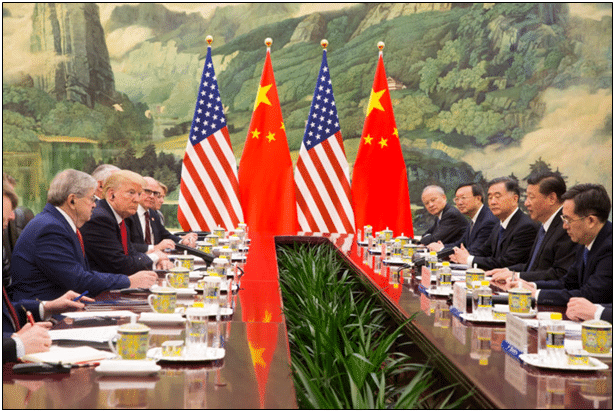
January 17, 2025
Permission to republish original opeds and cartoons granted.
Trump’s Tariff Threat On China Results In Dialogue, Just Like It Did For Canada And Mexico
| 
|
|
President-elect Donald Trump on Jan. 17 in a Truth Social post reporting that discussions have been initiated with Chinese President Xi Jinping on issues of trade relations, fentanyl, the TikTok app and other items, promising to reach resolution where possible on key items of disagreement. The announcement came after Trump had threatened in a post on Truth Social on Nov. 26 to increase the tariffs on Chinese goods to 35 percent on $250 billion of goods and 17.5 percent on the remaining $300 billion of goods. That would come atop the 25 percent and 7.5 percent tariffs already in effect on Chinese goods that Trump implemented and that President Joe Biden never rescinded. In the Nov. 26 post, Trump said the increase in the tariffs on China would be in place until the fentanyl and other narcotics shipments stop. Now, China is already responding, as is usually the case with Trump’s art of the deal. Similar tariff threats against Mexico and Canada have already resulted in new talks between Trump and the heads of state there, and commitments to secure U.S. borders with those countries. Exactly the same approach was taken by Trump in 2019, resulting in a June 7, 2019 deal between President Donald Trump and Mexican President Andres Manuel Lopez Obrador that avoided Trump’s threatened tariffs on May 30. Or in the case of Trump’s proposed annexation of Greenland — aimed at curtailing Chinese and Russian naval incursions occurring there — Denmark Prime Minister Mette Frederiksen had a call with Trump acknowledging the need to increase security for Greenland and that any decision will be up to Greenland itself. That’s how it works. Trump outlines his expectations if a deal cannot be reached on an issue — for example threatened tariffs, military, economic or other actions — and then those being hit with the actions have a choice to make, accept that as the outcome, or negotiate. And now they’re talking, and if they want to avoid the stick, they will act — or Trump will. |
Big Tech’s Steps Toward Free Speech
| 
|
|
The left-wing media is melting down over Meta founder Mark Zuckerberg’s recent decision to move Meta toward more of a free environment by rolling back the politically charged “third party fact checking” that has become largely biased over the past eight years. Perhaps inspired by fellow tech founder Elon Musk’s acquisition of X (formerly Twitter) and eventual endorsement of President Donald Trump, Zuckerberg is showing a newfound interest in Trump’s approach to free speech. Last week, Zuckerberg announced that Meta will end it’s controversial “third party fact checking” – which largely promoted mainstream views while flagging alternative viewpoints – and replace it with a community-driven system similar to what has become commonplace on X. In a video announcing the change, Zuckerberg admitted that fact checkers have eroded public trust with their blatant bias. “Fact checkers have been too politically biased and have destroyed more trust than they’ve created,” Zuckerberg said. “What started as a movement to be more inclusive has increasingly been used to shut down opinions and shut out people with different ideas, and it’s gone too far.” Mainstream media, largely the beneficiary of the draconian “fact-checking” system that became the enemy of free speech, is melting down at the loss of power. Whether Silicon Valley’s nod to free speech is simply an attempt to cozy up to the current administration remains to be seen. But Americans must continue to demand free speech in every influential public space. |
Trump’s Tariff Threat On China Results In Dialogue, Just Like It Did For Canada And Mexico

By Robert Romano
“I just spoke to Chairman Xi Jinping of China. The call was a very good one for both China and the U.S.A. It is my expectation that we will solve many problems together, and starting immediately. We discussed balancing Trade, Fentanyl, TikTok, and many other subjects. President Xi and I will do everything possible to make the World more peaceful and safe!”
That was President-elect Donald Trump on Jan. 17 in a Truth Social post reporting that discussions have been initiated with Chinese President Xi Jinping on issues of trade relations, fentanyl, the TikTok app and other items, promising to reach resolution where possible on key items of disagreement.
The announcement came after Trump had threatened in a post on Truth Social on Nov. 26 to increase the tariffs on Chinese goods to 35 percent on $250 billion of goods and 17.5 percent on the remaining $300 billion of goods. That would come atop the 25 percent and 7.5 percent tariffs already in effect on Chinese goods that Trump implemented and that President Joe Biden never rescinded.
In the Nov. 26 post, Trump said the increase in the tariffs on China would be in place until the fentanyl and other narcotics shipments stop, “I have had many talks with China about the massive amounts of drugs, in particular Fentanyl, being sent into the United States – But to no avail. Representatives of China told me that they would institute their maximum penalty, that of death, for any drug dealers caught doing this but, unfortunately, they never followed through, and drugs are pouring into our Country, mostly through Mexico, at levels never seen before. Until such time as they stop, we will be charging China an additional 10% Tariff, above any additional Tariffs, on all of their many products coming into the United States of America.”
Now, China is already responding, as is usually the case with Trump’s art of the deal. Similar tariff threats against Mexico and Canada have already resulted in new talks between Trump and the heads of state there, and commitments to secure U.S. borders with those countries.
Exactly the same approach was taken by Trump in 2019, resulting in a June 7, 2019 deal between President Donald Trump and Mexican President Andres Manuel Lopez Obrador that avoided Trump’s threatened tariffs on May 30 that would have been 5 percent starting on June 10, 10 percent on July 1 and then up to 25 percent by October.
At the time, Trump wrote on Twitter (now X), “On June 10th, the United States will impose a 5% Tariff on all goods coming into our Country from Mexico, until such time as illegal migrants coming through Mexico, and into our Country, STOP. The Tariff will gradually increase until the Illegal Immigration problem is remedied… at which time the Tariffs will be removed. Details from the White House to follow.”
Then the deal was cut days later, which included a Mexican military deployment to interdict the oncoming migrant caravan from Central America, as well as provision for asylum seekers to wait out pending hearings in Mexico without being allowed to cross into the U.S. Immediately following the agreement, encounters on the southern border with Mexico decreased from 144,116 in May 2019 to 45,250 by Oct. 2019, a 68.6 percent decrease.
Or in the case of Trump’s proposed annexation of Greenland — aimed at curtailing Chinese and Russian naval incursions occurring there — Denmark Prime Minister Mette Frederiksen had a call with Trump acknowledging the need to increase security for Greenland and that any decision will be up to Greenland itself. In press statement from the Prime Minister’s office from Jan. 15, it stated, “In the conversation, the Prime Minister emphasized the importance of strengthening security in the Arctic, and that the Kingdom of Denmark is ready to shoulder even greater responsibility for this.”
That’s how it works. Trump outlines his expectations if a deal cannot be reached on an issue — for example threatened tariffs, military, economic or other actions — and then those being hit with the actions have a choice to make, accept that as the outcome, or negotiate.
In every single instance, each head of state has chosen to talk instead, illustrating the utility of Trump’s approach, which can appear tough, because it is tough. After all, with China, the tariffs Trump put into place were never taken away by outgoing President Joe Biden, so Beijing knows that the threat is real. Trump will really do it. And now they’re talking, and if they want to avoid the stick, they will act — or Trump will.
Robert Romano is the Vice President of Public Policy at Americans for Limited Government Foundation.
To view online: https://dailytorch.com/2025/01/trumps-tariff-threat-on-china-results-in-dialogue-just-like-it-did-for-canada-and-mexico/
Big Tech’s Steps Toward Free Speech

By Manzanita Miller
The left-wing media is melting down over Meta founder Mark Zuckerberg’s recent decision to move Meta toward more of a free environment by rolling back the politically charged “third party fact checking” that has become largely biased over the past eight years.
Perhaps inspired by fellow tech founder Elon Musk’s acquisition of X (formerly Twitter) and eventual endorsement of President Donald Trump, Zuckerberg is showing a newfound interest in Trump’s approach to free speech.
Last week, Zuckerberg announced that Meta will end it’s controversial “third party fact checking” – which largely promoted mainstream views while flagging alternative viewpoints – and replace it with a community-driven system similar to what has become commonplace on X.
In a video announcing the change, Zuckerberg admitted that fact checkers have eroded public trust with their blatant bias. “Fact checkers have been too politically biased and have destroyed more trust than they’ve created,” Zuckerberg said. “What started as a movement to be more inclusive has increasingly been used to shut down opinions and shut out people with different ideas, and it’s gone too far.”
Mainstream media, largely the beneficiary of the draconian “fact-checking” system that became the enemy of free speech, is melting down at the loss of power.
The American people, however, are calling for more transparency from tech companies with regard to their “fact checking” agendas and say they believe social media companies are generally unfair and biased against Republicans.
A new YouGov survey covering Americans’ views on social media and free speech found that the public says by a 34-point-margin – 60 percent to 26 percent – that social media companies are not transparent about their fact-checking processes.
The public says 66 percent to 17 percent that more transparency is needed from social media companies when it comes to regulating speech on their platforms.
The public also says by a full 37 points – 57 percent to 20 percent – that social media companies are generally biased and unfair when it comes to fact-checking and censorship of opinions shared on their platforms.
The largest share of Americans – 28 percent – assert that social media companies are usually biased in favor of Democrats, compared to sixteen percent who say the companies are usually biased in favor of Republicans and 26 percent who say the companies are not biased either way.
Americas also say by nineteen points – 51 percent to 32 percent – that excessive censorship of diverse views is a serious problem on social media platforms.
The tide is turning in favor of free speech, which is a powerful sight to behold considering just a few years ago it appeared like the battle for free speech on mainstream social media platforms was hopeless.
However, with Musk’s acquisition of Twitter in 2022 a new precedent emerged, and with Trump’s successful reelection in 2024, tech influencers may be rethinking their allegiance to the draconian anti-free-speech agenda.
Whether Silicon Valley’s nod to free speech is simply an attempt to cozy up to the current administration remains to be seen. But Americans must continue to demand free speech in every influential public space.
Manzanita Miller is the senior political analyst at Americans for Limited Government Foundation.
To view online: https://dailytorch.com/2025/01/big-techs-steps-toward-free-speech/
